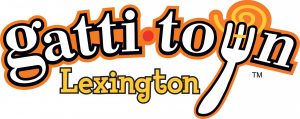Charlie and the Chocolate Factory Play Guide
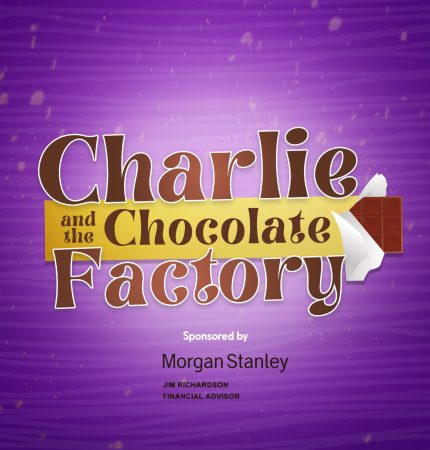
What to know – before the show!
[bs_collapse id=”collapse_1c20-4c89″]
[bs_citem title=”Play Synopsis” id=”citem_da61-783c” parent=”collapse_1c20-4c89″]
Our story begins with the Narrator informing the audience about Willy Wonka and his wonderful factory that has fallen victim to spies. Wonka’s factory has been closed for months until recently when a contest was announced in which five lucky winners could find a Golden Ticket tucked away under an ordinary wrapper of Mr. Wonka’s candy. The winners of the Golden Tickets will get the opportunity to tour Wonka’s famous chocolate factory. The Narrator introduces the first four Golden Ticket winners: August Gloop, a gluttonous child, Violet Beauregarde, a precocious gum-chewer, Veruca Salt, a spoiled little girl, and Mike Teavee, a violent boy obsessed with watching television.
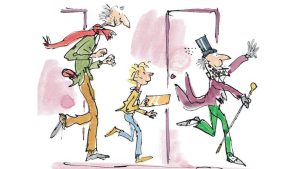
The audience is then meets Charlie Bucket, a poor yet humble child who lives in a very run down and cramped house with his parents and both sets of grandparents. Charlie’s grandparents aren’t pleased with the behavior of the other ticket winners. They had hoped Charlie would win the last Golden Ticket through the special bar of chocolate he had bought with his birthday money, but he didn’t. A few days later, Charlie comes home full of excitement and tells his family about how he found fifty cents on the ground while out walking. With no one around to claim the money, Charlie purchased a bar of chocolate. After eating the first bar, Charlie bought a second bar of chocolate and, to his surprise, found the remaining Golden Ticket. His family cheers at his triumph.
Shortly after, the day of the Wonka Factory tour arrives. Charlie chooses to take Grandpa Joe with him on the tour. Charlie excitedly reads the instructions written on his Golden Ticket as his fellow ticket winners arrive. Soon Willy Wonka enters to greet the five lucky children who each have various reactions to meeting the famous chocolatier spanning from excitement to indifference to disgust. Wonka doesn’t seem to mind as he leads the group into his factory. They first enter the Chocolate Room where they spot a long chocolate river and Wonka’s workers. Willy Wonka explains that his workers are Oompa-Loompas that come all the way from the dangerous country of Loompaland. While Wonka tells how the Oompa-Loompas became his business partners, August Gloop’s gluttony gets the better of him and he falls into the chocolate river. Augustus is sucked up a pipe headed straight for the Fudge Room. Wonka sends Mrs. Gloop off with the Oompa-Loompas to find Augustus.
Wonka then leads the tour group through the halls of his factory. They eventually come to the Invention Room filled with all sorts of strange machines. One such machine produces a stick of gum that Willy Wonka announces is a chewing gum meal. Violet is intrigued and takes the gum from Wonka despite his feeble protests that the gum isn’t quite ready for testing yet. As she chews, she reports that the gum tastes great, but then her mother notices that her daughter is turning blue. Violet turns blue all over and swells up like a blueberry forcing Wonka to send Violet and her mother off to the Juicing Room for de-juicing.
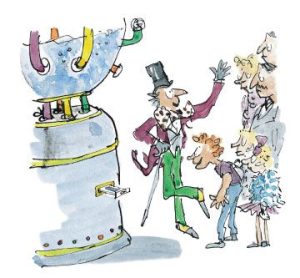
With just three ticket winners remaining, the tour continues on to the Nut Room where hundreds of miniature squirrels are hard at work deshelling walnuts. Veruca Salt demands that her father get her one of the trained squirrels, but Wonka informs her that they aren’t for sale. Dissatisfied with being told no, Veruca enters the squirrels’ work area to grab one for herself. However, the squirrels turn on her and pin her down, dragging her across the floor before sending her down the rubbish chute for being what they deemed a bad nut. Willy Wonka attempts to reassure Mr. and Mrs. Salt that Veruca is likely fine by stating that she could easily just be stuck in the chute, and if not, she can be found in the incinerator that is only lit every other day, though Wonka isn’t certain which day the current day is. As the Salts race away to find their daughter before she’s burned to a crisp, Mike complains about being tired and wanting to watch television which gives Wonka an idea.
The tour group makes their way to the Great Glass Elevator that can move sideways, longways, slantways, and any other way one can think of. They get off the elevator at the Television Chocolate Room, a room that allows Wonka to send a bar of chocolate from one end of the room to the other by way of television. He demonstrates this impressive phenomenon much to the surprise of Mike Teavee who has spent the entire tour bored. Mike races over to the machine so he can send himself across the room. In doing so, he ends up a miniature version of himself. Wonka instructs Mr. Teavee to take tiny Mike to his stretching machine to help him grow and prescribes a series of super vitamin candies to help.
Charlie is now the only Golden Ticket winner left. Willy Wonka isn’t surprised that Charlie is the last one standing, so he offers Charlie the greatest prize: his chocolate factory. Wonka explains that he is getting older and it’s now harder to carry out his ideas. He is in need of help, so he wants Charlie and the rest of the Bucket family to come live in the chocolate factory and help run it. Wonka offers to train Charlie and teach him everything he knows because the contest helped him recognize that Charlie is the most suitable heir to his company. Charlie accepts the offer with enthusiasm noting that he and his family will never be poor and hungry again. [/bs_citem]
[bs_citem title=”Play Before the Play” id=”citem_06cd-5909″ parent=”collapse_1c20-4c89″]
AMAZING CHOCOLATIERS
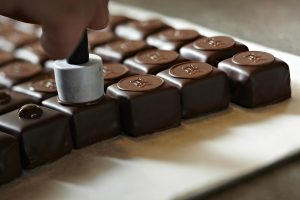
In Charlie and the Chocolate Factory, Willy Wonka is the eccentric founder of Wonka Chocolate Factory. He is known for creating wacky confections such as gum that tastes like other foods and candy that never loses its flavor or gets any smaller. Ask your students to think about what candies they would like to invent. Provide each student with a copy of one of the worksheets from the link below.
[bs_button size=”md” type=”primary” value=”Create a Wacky Candy” href=”https://www.lctonstage.org/wp-content/uploads/2023/02/Candy-Worksheet.pdf”]
As students work to design their new candies, encourage them to think about their favorite sweet treats and the ingredients used to make them. What do they like about their favorite sugary snacks? Below are a list of ingredients to help inspire your budding candy makers:
[bs_row class=”row”]
[bs_col class=”col-sm-6″]
Coconut
Peanut Butter
Cookie Pieces
Rice Krispies
Marshmallows
[/bs_col]
[bs_col class=”col-sm-6″]
Fruit
Peppermint Pieces
Chocolate
Caramel
Nuts
[/bs_col]
[/bs_row]
Extend the Experience:
For some hands on candy making fun, bring in melted chocolate and other ingredients to allow the students to create their own chocolate confections. Ingredients can be marshmallows, gummy bears, sprinkles, or lavender. Allow students to choose their ingredients and add it to the melted chocolates. Pour the chocolate into silicone molds and let them set. The students should also think of a name for their new chocolate creations. Once the chocolates have set, have the students try each other’s confections and discuss which ones they liked and which ones were not for them. You can even have students write out their recipes to make into a fun recipe book for the whole class!
KAS: 2-PS1-1; 2-PS1-4; 5-PS1-2
AS SEEN ON TV!

In the Television Chocolate Room, Willy Wonka invents an incredible machine to help create amazing ads for his chocolate bars. Now that your students have brainstormed their own candy creations, they should market their product by creating their own magazine ad and television commercial. The magazine ad should be designed to take up one page. Collect some examples and use them to help guide students on how to create their ad. Remind students that their ad should be catchy and convey information succinctly. Encourage students to use the following techniques in their ad: bold writing, colorful pictures, and catchy words.
After designing the magazine ads, divide your students into small groups of 3-4 and have them work together to come up with designs for the wrappers for their candies. Then have each group create a commercial to promote their new candies sold by Wonka Chocolate. It is their job to think of ways to inform people and convince them to buy their new confections. Have students describe their creations. How does it taste? What makes it special? Where can customers buy it? How much does it cost? Encourage students to consider where they want to set their commercials. It could be a grocery store or a movie theater. Whether it’s practical or outrageous and silly, any idea is a good one when selling Wonka Chocolate bars! Allow students to rehearse their commercials before performing them for the class. For added fun, you can have students film and edit their commercials with fun effects to show to the class onscreen.
KAS: F.P.8, C.I.3, C.2.2,C.4.2; VA:Cr1.1.5
MACHINES
Within the Wonka Chocolate Factory, there are many machines that help make the different candies. Each part has a specific job, such as wrapping the candy, pouring melted chocolate, or mixing ingredients. Have the students use their bodies, voices, and imagination to create a machine. Some space is needed for this activity to be done as a whole group, but small groups are also doable. The students should stand to the sides of the room, so there is space in the middle. One at a time, a person will go in and become one part of the candy making machine. There should be a movement and noise to make this part. Everyone off to the sides should watch what the people are doing to know where they can fit into the machine. Once everyone is in, the teacher can have the students go fast, slow, loud, or quiet.
KAS: TH:Pr5.1.4.a; TH:Cr3.1.4.b; TH:Cn11.2.-1.b; K-2-ETS1-2 [/bs_citem]
[bs_citem title=”Contextual Article” id=”citem_f776-0ab0″ parent=”collapse_1c20-4c89″]
A WORLD OF PURE IMAGINATION: THE MANY ADAPTATIONS OF CHARLIE AND THE CHOCOLATE FACTORY
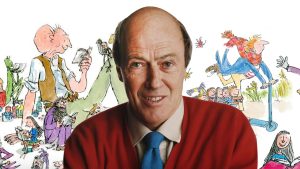
Charlie and the Chocolate Factory started as a book written in 1964 by British author Roald Dahl. The story revolves around Charlie Bucket, and his adventures within Willy Wonka’s chocolate factory. The story was inspired by Dahl’s childhood when chocolate companies, such as Cadbury, would send chocolates to schoolchildren for their opinions in return. Charlie and the Chocolate Factory has been considered one of the most popular works in children’s literature, though it has received criticism, particularly for its depiction of the Oompa Loompas. Due to these criticisms, edits were made to future editions of the original book.
In 1972, Roald Dahl wrote a sequel entitled Charlie and the Great Glass Elevator. The story starts where the first novel stops, with Charlie, Grandpa Joe, and Wonka travelling in the Glass Elevator. Things go awry, and the elevator shoots into space, making everyone believe it was an act of space piracy. There was supposed to be a third book in the series, Charlie in the White House, but only the first chapter was written. That chapter is currently on display at the Roald Dahl Museum and Story Centre.
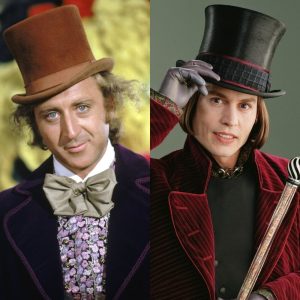
The first movie adaptation of this beloved story premiered in 1971 with Gene Wilder starring as Willy Wonka. Dahl served as part of the creative process for the film by assisting with writing the screenplay. However, he would later disown the film when another writer was brought onboard to make edits with other changes being made by the director. Still, the movie’s production carried on without Dahl. Creating the set and props was an intricate process. Roughly one-third of the set in the chocolate room were actually edible, such as the chocolate watermelon eaten by Veruca Salt and even the leaves on the trees. Other items were not edible like Wonka’s flower cup made of wax which Gene Wilder would chew then spit out between takes.
Charlie and the Chocolate Factory was famously adapted once more in 2005 with Johnny Depp starring as Willy Wonka. This adaptation followed the original source material closer than the 1971 film. And while special effects were becoming popular during this time, Tim Burton, the director, wanted most of the magic to be found within the set and practical effects. The squirrels in Veruca’s scene were trained from birth to successfully complete the action. To create the chocolate river, the crew used water, a thickening agent called Natrosol, and brown dye, making it edible as well.
Roald Dahl’s story continues to be adapted today. Another film adaptation called Wonka is slated to premier in December 2023 with Timothée Chalamet set to play a young Willy Wonka with. Even more, the book has been adapted for the stage several times, most recently with the musical Charlie and the Chocolate Factory which opened on Broadway in 2017. Designers used bright colors for the costumes, set, and lighting to create the whimsical Wonka world. For the Bucket home, the set designer created a two-level piece with the family sharing one bed at the top. Everyday objects are placed all about to show the clutter within the home, though it still has a cartoonish vibe.
The version performed by Lexington Children’s Theatre is a one act play. As you watch the production, pay attention to the set pieces to see if you can tell how our candy was made!
[/bs_citem]
How to grow – after the show!
[bs_citem title=”Extend the Experience” id=”citem_80f2-66bf” parent=”collapse_1c20-4c89″]
SWEET SCIENCE
Mr. Wonka needs help in his factory testing candy to make it better and more durable. The following experiment can be done in small groups. This experiment will require:
- Gummy Worms
- Laffy Taffies
- Skittles
- M&Ms
- Mints
- Smarties
- 6 cups of water (1 for each candy)
Start by printing a worksheet for each group using the link below:
[bs_button size=”md” type=”primary” value=”Sweet Science Activity” href=”https://www.lctonstage.org/wp-content/uploads/2023/03/Candy-Experiment.pdf”]

Have students write down each of the candy options in the “object” column. Ask your students to discuss their predictions in their groups: What candies will sink, which will float, and why? Then, one by one, have your students drop a piece of candy into a cup of water. Students should mark their observations by placing an ‘X’ in either the sink or float box next to each candy. Encourage students to make additional observations (does the candy dissolve, change color, change consistency, etc.). For added fun, ask students if they think the results would change if a different liquid was used (such as carbonated water or a milkshake). Let students test their candies across lots of variables and see what they find!
The Science Behind It
Everything is made up of molecules – teeny tiny particles that can only be seen with a microscope. If those molecules are packed very closely together, like those of an M&M, they are denser than the water molecules which causes the object to sink. If the molecules are spread apart and have space between them, like a marshmallow, they are less dense than the water and will float!
KAS: 2-PS1-1; 2-PS1-2
CANDY FACTORY CONSTRUCTION
For this activity, your students will think outside the box by designing inside the box. Allow students to create their own miniature candy factory rooms through shoebox dioramas. Divide students into small groups and provide each group with empty shoebox and a variety of craft supplies. Ask students to build a room they believe would be found in Willy Wonka’s Factory. Encourage students to think of a new room different from the known rooms mentioned in Charlie and the Chocolate Factory. What sweet treat will the room be themed around? Maybe they could have a garden for gummy worms and planting jellybeans, or an experimenting room for testing new candies. Or maybe even a giant water themed room with Swedish fish swimming around! The possibilities are endless! Once all groups are done, put the dioramas together to complete the factory.
Extend the Experience:
Take a tour of your class’s version of Wonka’s factory. Have students get up on their feet and move around the space as if they are in each room of the factory. Act out scenarios that might happen in each room. Allow students to enter a world of pure imagination as they explore the whimsical world of Willy Wonka!
KAS: TH:Cr3.1.3.b; VA:Cr2.1.2; VA:Cr2.3.2
INNER THOUGHTS
Charlie Bucket might have come out of Wonka’s factory unscathed, but the same can’t be said for the other golden ticket winners. Have your students choose one of the other ticket winners:
Augustus Gloop
Violet Beauregarde
Veruca Salt
Mike Teavee
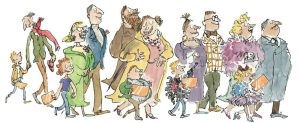
Have them write a diary entry as if they are that character. What happened to their chosen character? How did they feel about the events of their day spent at Wonka’s factory? Did they learn any valuable lessons? Would they change anything about their day? Encourage students to think about how life might have changed for their character after being shrunk or blowing up into a giant blueberry. What advice would their character give to a future golden ticket winner? Once students are done writing, have them share their inner thoughts with the class by reading their diary entry.
KAS: TH:Re8.1.2.b; C.3.3.b; C.3.3.c
[/bs_citem]
[bs_citem title=”Suggested Reading” id=”citem_b02e-8888″ parent=”collapse_1c20-4c89″]
If you whimsical, silly stories, you might also like…
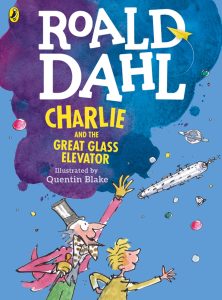
Charlie and the Great Glass Elevator by Roald Dahl
Now that Charlie Bucket has won the chocolate factory, what’s next for him, his family, and Mr. Wonka?
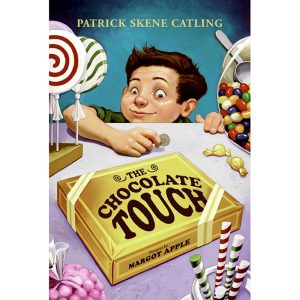
The Chocolate Touch by Patrick Skene Catling
When John Midas acquires a magical gift, everything his lips touch turns into chocolate.
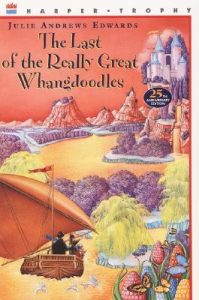
The Last of the Really Great Whangdoodles by Julie Andrews Edwards
Tom, Ben, and Lindy journey with Professor Savant to a mysterious land in search of the Whangdoodle, an extraordinary creature that has disappeared from the world.
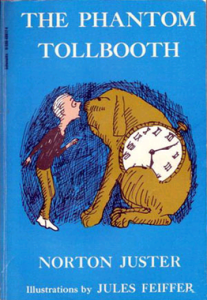
The Phantom Tollbooth by Norton Juster
For Milo, everything’s a bore. But when a tollbooth mysteriously appears in his room, he drives through and soon realizes that life is far from dull.
[/bs_citem]
[/bs_collapse]
Educational materials sponsored by



